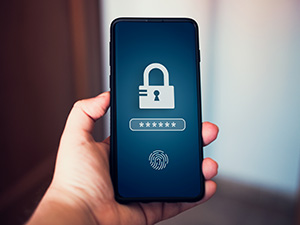
Gone are the days when mobile phones were simple devices used only to make calls. Nowadays, our mobile devices are advanced, handheld supercomputers that can do everything from paying a bill, to ordering lunch for delivery, to editing videos, and much more.
However, as the range of capabilities expands, so do the associated risks. Because our phones are computers and connected to the Internet, they are vulnerable to the same security threats that any other computer would be. Furthermore, personal devices often contain private information like bank account numbers. If accessed by the wrong person, this could result in dangerous and expensive problems like depleted bank accounts, identity theft, and other costly issues. Nevertheless, despite the obvious risks, most people do not treat phones as the potential security risks they are, making them attractive targets for cybercriminals.
To give perspective on how severe the problem is, Apple recently released a report from MIT revealing a shocking 2.6 billion personal records were breached in 2021 and 2022 and were expected to increase in 2023. In just the third quarter of 2023, Kaspersky Security Network managed to block a total of 8,346,169 mobile malware, adware, and riskware attacks, with adware being the most common tactic at 52% of total detected threats.
The risks are even more serious for business owners. Does your company have a mobile policy for employees? Are employees using unsecured devices to access important work files or accounts? If you’re unsure, you need your IT department to investigate this immediately. A hacker can easily breach your network with just a single-entry point.
There are a few ways to protect your devices now. Apple and Android have both developed powerful security systems that offer advanced protective features you can start utilizing today.
Apple:
Apple has always made sure to prioritize security by implementing end-to-end encryption as the default setting for iMessage, iCloud Keychain, and Health data. A recent update, however, rolled out Advanced Data Protection (ADP), adding an additional layer of protection. This feature is an optional setting that offers Apple's highest level of cloud data security by encrypting messages in iCloud, iCloud Backup, Notes, Photos, Safari bookmarks, Siri Shortcuts, and more.
Activating this setting safeguards your data in the event of a cloud-based data breach by only allowing trusted devices added by you to decrypt the information. Not even Apple can access your data.
Here’s how to enable Apple’s Advanced Data Protection Setting:
- Make sure devices signed in with your Apple ID have been updated to at least iOS 16.2, iPadOS 16.2, macOS 13.1, tvOS 16.2, watchOS 9.2 or later.
- Open the Settings app on your iPhone.
- Tap your name at the top.
- Select iCloud, scroll to the bottom, and tap Advanced Data Protection.
- Tap Turn On Advanced Data Protection.
NOTE: If you haven’t set up a recovery contact or key, you’ll be prompted to do that first.
- Once a recovery contact/key is set up, return to Settings > iCloud > Advanced Data Protection and tap Turn On Advanced Data Protection.
- Follow the prompts.
NOTE: Before you can activate end-to-end encryption (E2E), you might need to update any other devices that are logged into your iCloud account.
You can also remove devices with old software to continue the process.
If your device is brand new, Apple might make you wait a bit before enabling the feature, for security purposes. If that happens, you’ll see that timeframe displayed on your screen during setup.
Android:
Apple is known for having a robust security system that reduces vulnerabilities and protects users’ data. However, Android’s security features are also quite impressive.
Google Play Protect examines every app before it becomes available for download, and any newly discovered apps with potential security risks detected are unable to be accessed. The software runs scans daily to help detect and disable malware and other harmful applications that may have been installed on your phone, ensuring the safety of your data.
Additionally, Android backups are regularly uploaded to Google servers and encrypted with your Google Account password for security purposes.
How to keep data secure if you’re using an Android:
If you’re using Google One, you can enable automatic backups on your Android device to ensure that, if disaster strikes, your data is securely stored in the cloud:
- Open the Google One app on your Android.
- At the bottom, tap Storage.
- Scroll to “Backup” and tap View.
- If this is your first phone backup, tap Set up data backup.
- If this isn’t your first phone backup, tap View Details.
- To review backup settings, tap Manage backup.
- Choose your backup settings.
NOTE: If you get a message to install an app, update an app or change your settings, follow the onscreen steps. Then, go back to the Google One app to finish.
- If asked, tap Allow Permissions.
- At the top left, tap Back.
NOTE: Google One backups may take up to 24 hours to complete.
How To Protect All Of Your Devices:
These features are not the ultimate solution for phone security, but they will add a layer of protection for your data. To ensure every device on your network is secure, we recommend a Cybersecurity Risk Assessment from a trusted third party. Our team will conduct a complementary, no-obligation assessment where one of our experts will examine your network, including your mobile device policy, and identify any potential vulnerabilities.
Click here to schedule your assessment with one of our senior advisors or call us at 281-646-1200.



